
Apollinary Vasnetsov and the world of his landscapes: Moscow, the Russian North, the Urals and the Siberian expanses
Apollinary Mikhailovich Vasnetsov (Apollinary Mikhailovich Vasnetsov; July 25 (August 6), 1856 – January 23, 1933) was a renowned Russian landscape painter, historical artist, graphic artist, decorator, and art historian of the 19th and 20th centuries. The paintings of Apollinary Mikhailovich Vasnetsov absorbed his boundless love for his native land, nature, and the country's history. In his works, he captured the harsh beauty of the northern regions and the vast expanses of Siberia, conveyed the poignant melancholy of the landscapes in the central part of the country, and recreated the life of ancient Moscow, capturing the festive beauty of its temples. A significant role in the master's biography is played by his scientific work - he was interested in historical and archaeological research, which ensured a high degree of accuracy in his paintings.
Apollinary Mikhailovich Vasnetsov worked in a realistic style, but at the same time, his works bear traces of Impressionism. Mood plays a significant role in the artist's paintings.
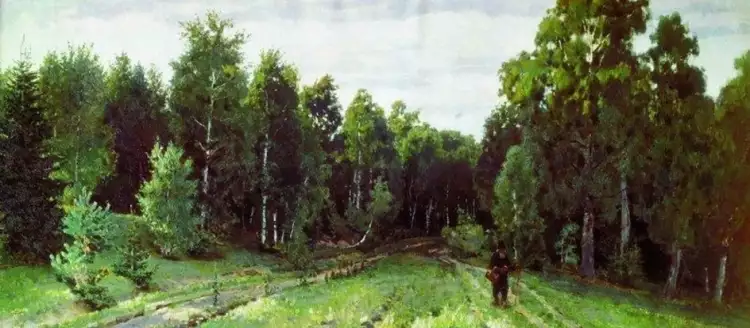 Apollinary Vasnetsov. Painting Forest Path, 1885
Apollinary Vasnetsov. Painting Forest Path, 1885
Biography of Apollinary Mikhailovich Vasnetsov
Apollinary Mikhailovich Vasnetsov was born on July 25 (August 6), 1856, into a family of hereditary clergy. His father, Mikhail Vasilyevich Vasnetsov, was a simple priest. The family lived in the village of Ryabovo near the town of Vyatka. His mother's name was Apollinariya Ivanovna.
The Vasnetsov family had many children, and two of them were destined to glorify Russia with their paintings. Apollinary's older brother was the famous artist Viktor Mikhailovich Vasnetsov, known for such renowned paintings as "Bogatyri" (Heroes), "Alyonushka," and "The Carpet Plane." While Viktor was drawn to magical and fairy tale subjects, Apollinary's destiny led him to enter the history of art with realistically inspired landscapes and paintings reconstructing the historical life of Russia.
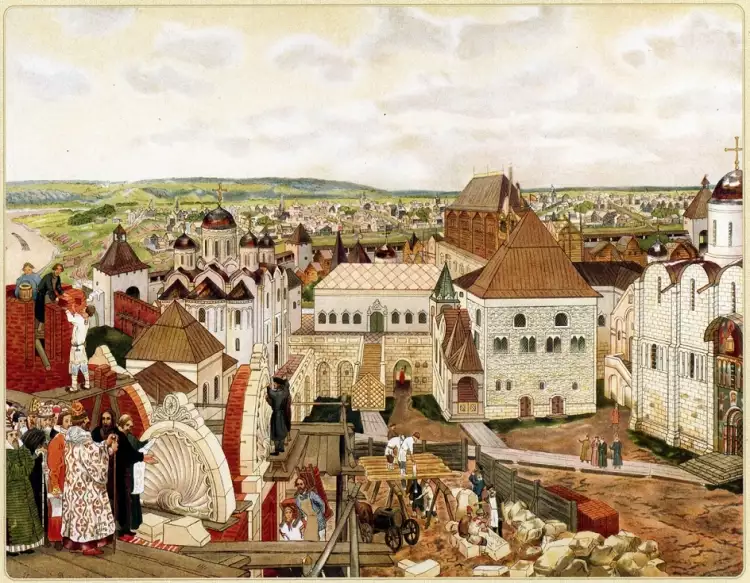 Apollinary Vasnetsov. Painting In the Moscow Kremlin
Apollinary Vasnetsov. Painting In the Moscow Kremlin
Apollinary grew up as a gifted child, showing an early talent for art. However, fate was not particularly kind to the boy. At the age of ten, he lost his mother, and four years later, he lost his father as well. This was a heavy blow for the young painter, as it was his father (also possessing artistic talent) who nurtured in him a love for nature and sparked his gift for landscape painting.
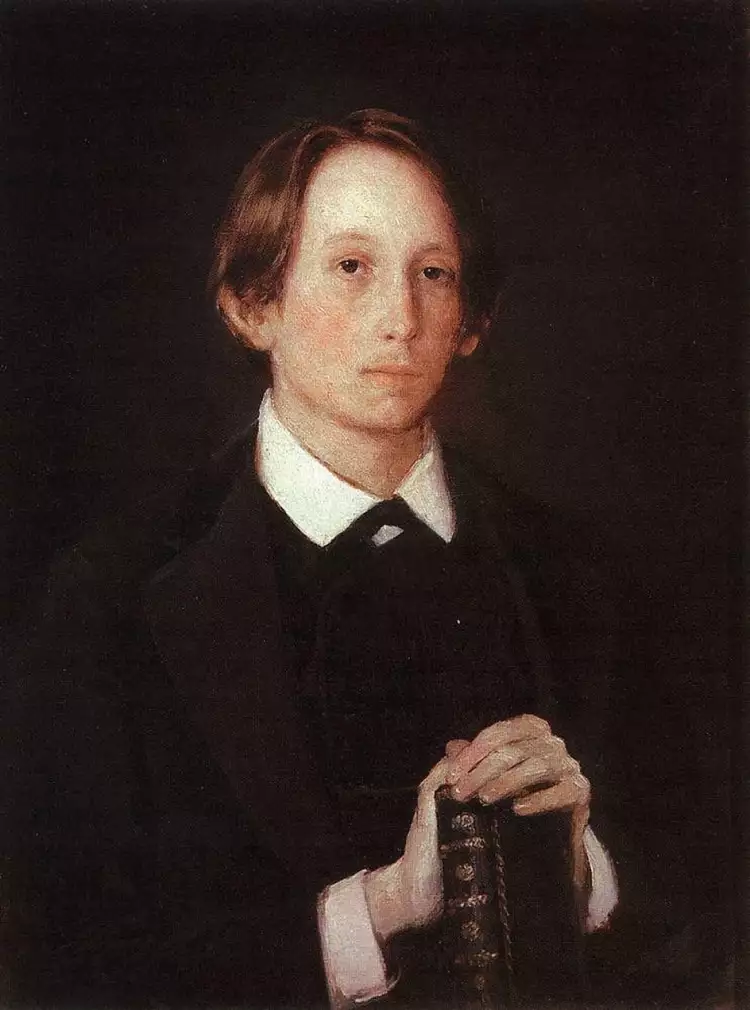 Apollinary Vasnetsov. Viktor Vasnetsov. Painting Portrait of A. M. Vasnetsov, 1878
Apollinary Vasnetsov. Viktor Vasnetsov. Painting Portrait of A. M. Vasnetsov, 1878
The following years were challenging for Apollinary. He studied at the Vyatka Spiritual Seminary, which he later remembered with less than favorable words. However, there were bright moments in his life. Once, when visiting Vyatka, Viktor Vasnetsov, who was already studying in the capital, noticed the creative debuts of the teenager and realized that his younger brother's talent was not receiving proper development. Upon Viktor's recommendation, the young artist began taking lessons once a week from the Polish painter Michał Elwiro Andriolli, who happened to be in Vyatka as an exile.
The main emphasis in his education was on landscape painting: Apollinary copied the works of the Swiss painter Alexandre Calame, renowned for his depictions of alpine landscapes, and also painted views of his native Russian North from life, which opened directly from his window.
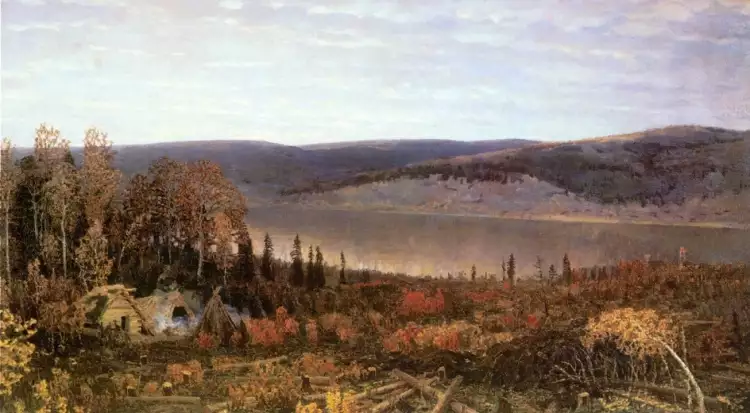 Apollinary Vasnetsov. Painting Kama, 1895
Apollinary Vasnetsov. Painting Kama, 1895
After completing the seminary, sixteen-year-old Apollinary went to St. Petersburg, urged by Viktor Vasnetsov, who wanted to open the doors to the professional world of painting for his brother. However, the young man did not immediately understand where his recognition lay. For some time, he contemplated entering the Geological Institute, and then, fueled by populist ideas, he decided to become a rural teacher and returned to his native Vyatka Province. There, in the village of Bystritsa, he taught for three years. But reality did not align with his populist ideals. In the end, he realized that his true path and calling were in the realm of art.
In 1875, Apollinary moved to Moscow, which became one of the main themes of his paintings. It was also during this time that Viktor settled there, introducing his brother to the artistic community. Although the younger Vasnetsov did not enter the Academy of Fine Arts, he persistently elevated his professional level. He was significantly influenced by the atmosphere of the so-called Abramtsevo Circle, which brought together the creative forces of the progressive intelligentsia.
Apollinary received lessons from Vasily Dmitrievich Polenov, Ilya Yefimovich Repin, Vasily Maximovich Maximov, Mark Matveyevich Antokolsky, and also learned from his older brother.
The first painting that brought Apollinary Vasnetsov professional recognition in wider circles was "Grey Day," or "Little Grey Day" (1883). This work was acquired by the great Russian patron and collector Pavel Mikhailovich Tretyakov, thereby granting the young artist a "ticket" to the community of significant or, at the very least, promising masters of the brush. In this work, Apollinary Vasnetsov's style was already evident: the modest landscape against the backdrop of a gray sky may appear unpretentious, but it evokes a sense of tranquility and serenity.
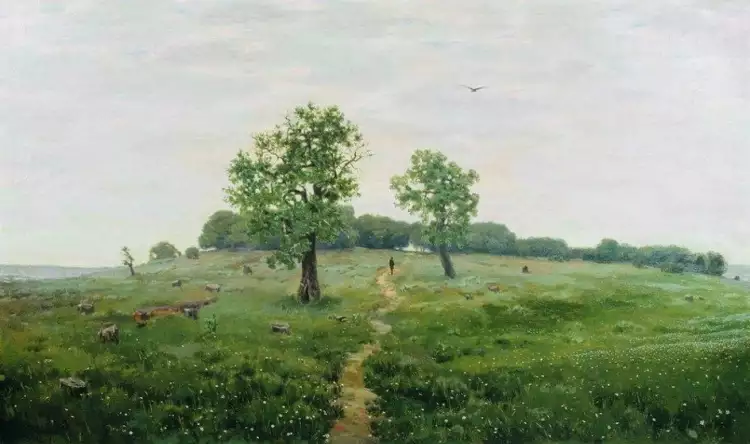 Apollinary Vasnetsov. Painting Grey Day, 1883
Apollinary Vasnetsov. Painting Grey Day, 1883
In 1885-1886, Vasnetsov embarked on a grand journey throughout the Russian Empire. The result was artworks in which the mighty currents of the Dnieper, Kama, and Siberian rivers flowed, the Ural Mountains stood tall, and the impenetrable taiga rustled...
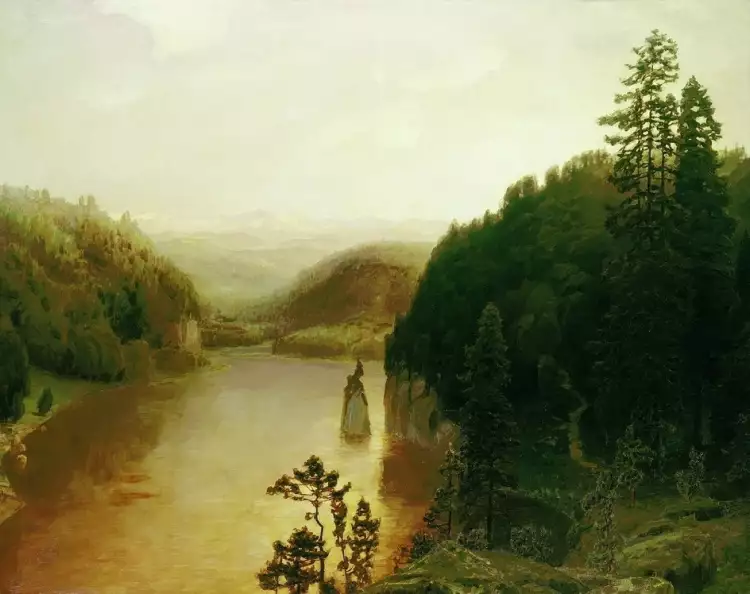 Apollinary Vasnetsov. Painting Lake in Bashkiria, 1885
Apollinary Vasnetsov. Painting Lake in Bashkiria, 1885
But Apollinary Mikhailovich saw his calling not only in landscape painting. He spoke of his equal, if not greater, passion for scientific work and the study of antiquity. In the field of science, Vasnetsov was a professional and a member of the Moscow Archaeological Society.
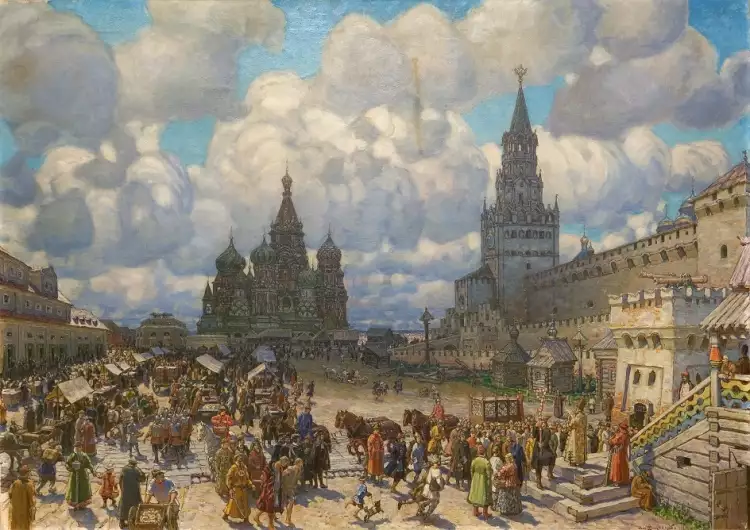 Apollinary Vasnetsov. Painting The Red Square in the Second Half of the 17th Century, 1925
Apollinary Vasnetsov. Painting The Red Square in the Second Half of the 17th Century, 1925
By combining these two spheres of activity, which inspired him—science and art—Vasnetsov painted pictures that recreated the former appearance of Russian cities.
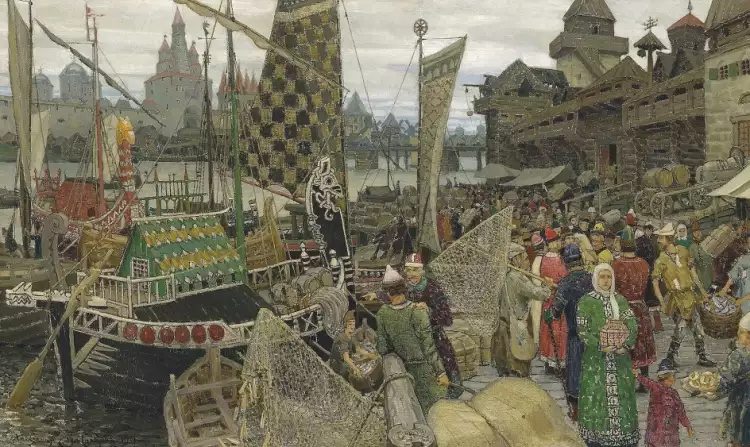 Apollinary Vasnetsov. Painting Ancient Great Novgorod, 1901
Apollinary Vasnetsov. Painting Ancient Great Novgorod, 1901
In this domain, he gained fame as the author of decorations for historical operas and performances.
The master's creativity received widespread acclaim. Although he never became a student of the Academy of Fine Arts in his youth, in 1900, he was awarded the title of academician by that institution. From 1901 to 1918, Apollinary Mikhailovich engaged in teaching activities.
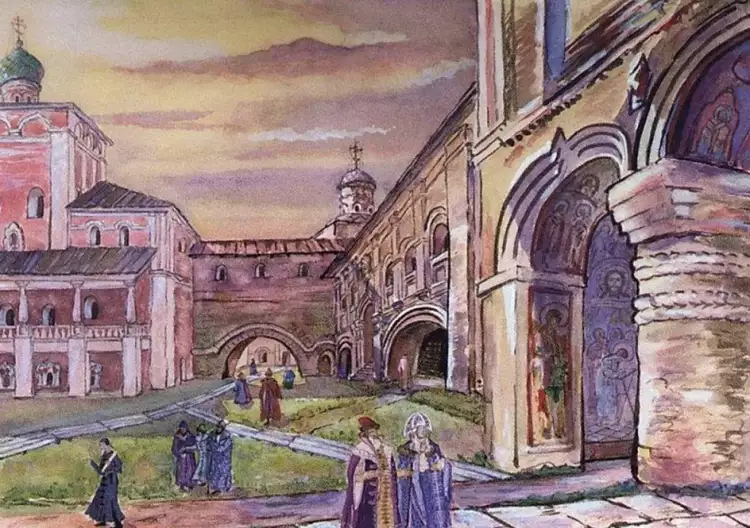 Apollinary Vasnetsov. Painting Kirillo-Belozersky Monastery, 1915
Apollinary Vasnetsov. Painting Kirillo-Belozersky Monastery, 1915
With deep reverence for the spiritual traditions of the people, the artist painfully perceived the campaign that began after the revolution to destroy churches. He was the only painter who dared to speak out against the demolition of the Moscow Cathedral of Christ the Savior in 1931, sending an open appeal to the "Izvestiya" newspaper.
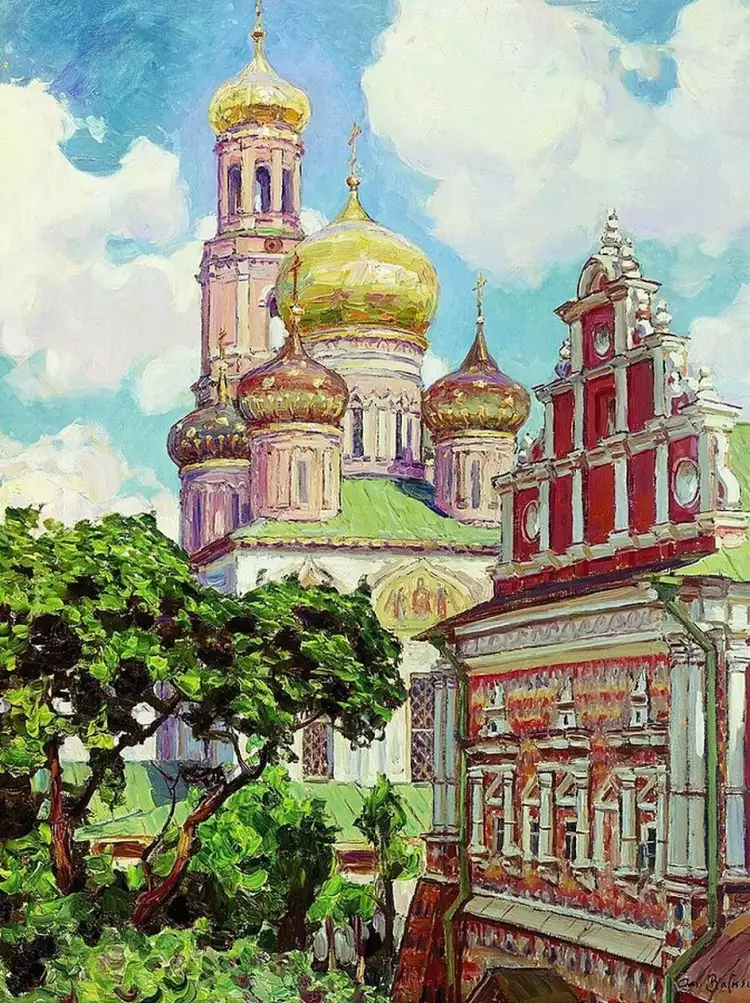 Apollinary Vasnetsov. Painting Simonov Monastery. Clouds and Golden Domes, 1927)
Apollinary Vasnetsov. Painting Simonov Monastery. Clouds and Golden Domes, 1927)
It is unknown how this courage would have been met during the era of repression, but the artist departed from this world before the repressive policies of the state reached their peak. Apollinary Vasnetsov, 76 years old, passed away on January 23, 1933.
The most famous paintings of Apollinary Mikhailovich Vasnetsov
Apollinary Mikhailovich Vasnetsov's works are currently housed in renowned museums in Russia, including the Tretyakov Gallery. A number of his works are displayed in the Memorial Apartment Museum of the artist. Among the most famous paintings by Apollinary Vasnetsov are:
- "Motherland" (1886) - one of the master's most recognizable landscapes, where he admires the vast expanses of Russia. Though the fields, meadows, and the small village nestled among them may appear poor and simple, and the sky overcast with an unsaturated palette, one can feel the artist's deep connection to his native land.
- "Taiga in the Urals. Blue Mountain" (1891) - a work through which Apollinary Vasnetsov opens a window for viewers into the majestic world of the Ural forests. This region is harsh and even somewhat gloomy, rarely touched by human footsteps. Yet, beauty also exists here - the grand beauty of untouched nature.
- "Moscow Kremlin. Cathedrals" (1894) - an urban landscape presenting one of the most famous views of Moscow. The peculiarity of this work lies in its pastel palette. The Kremlin wall and cathedral domes bathe in the soft rays of dawn.
- "Northern Frontier. Siberian River" (1899) - a painting that remarkably captures the boundlessness of the Siberian expanse. The shimmering ribbon of a great river stretches into the distance, merging with the infinite sunset skies on the horizon.
- "Street in Kitai-Gorod. Early 17th Century" (1900) - a historical urban landscape in which Apollinary Mikhailovich reconstructed a fragment of ancient Moscow. The vibrant life of the famous trading quarter unfolds under the silhouette of the Cathedral of Vasily the Blessed, against a shimmering pearly dawn.
- "Vsekhsvyatsky Stone Bridge" (1901) - another reconstruction work dedicated to the history of Moscow. The artist invites us to admire the Kremlin in the times when its walls were white and when the first stone bridge was built in the capital of Rus, which we see in the painting.
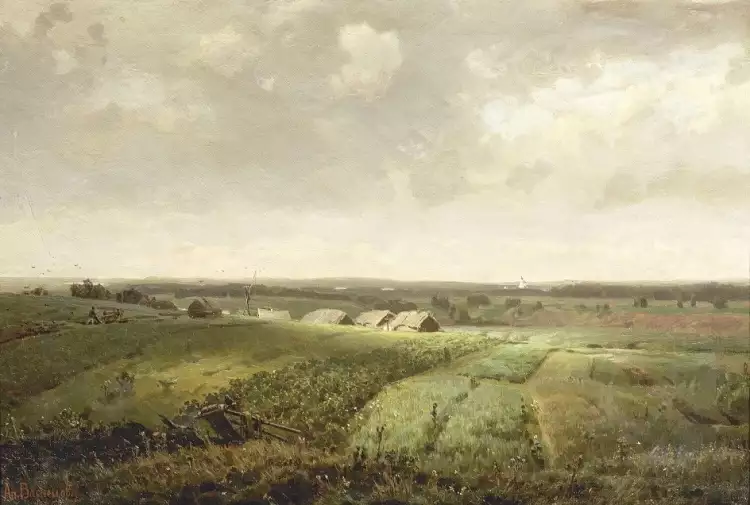 Apollinary Vasnetsov. Painting Motherland, 1886
Apollinary Vasnetsov. Painting Motherland, 1886
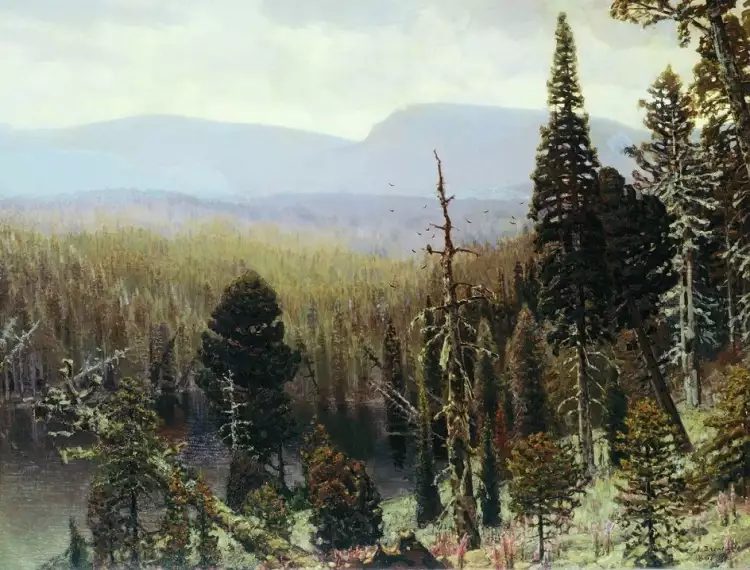 Apollinary Vasnetsov. Painting The Taiga in the Urals. Blue Mountain, 1891
Apollinary Vasnetsov. Painting The Taiga in the Urals. Blue Mountain, 1891
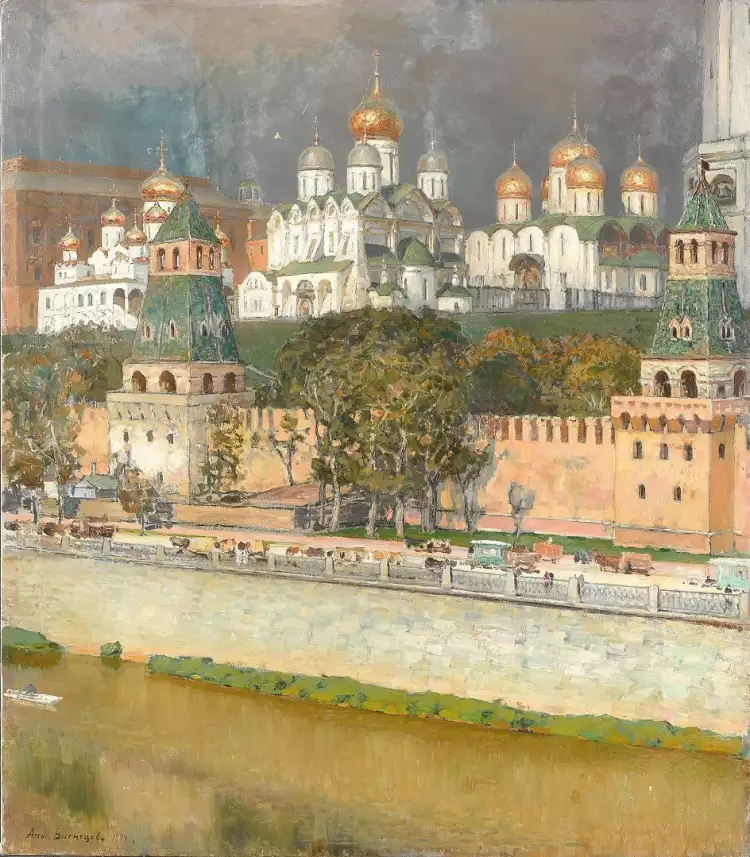 Apollinary Vasnetsov. Painting Moscow Kremlin. Cathedrals, 1894
Apollinary Vasnetsov. Painting Moscow Kremlin. Cathedrals, 1894
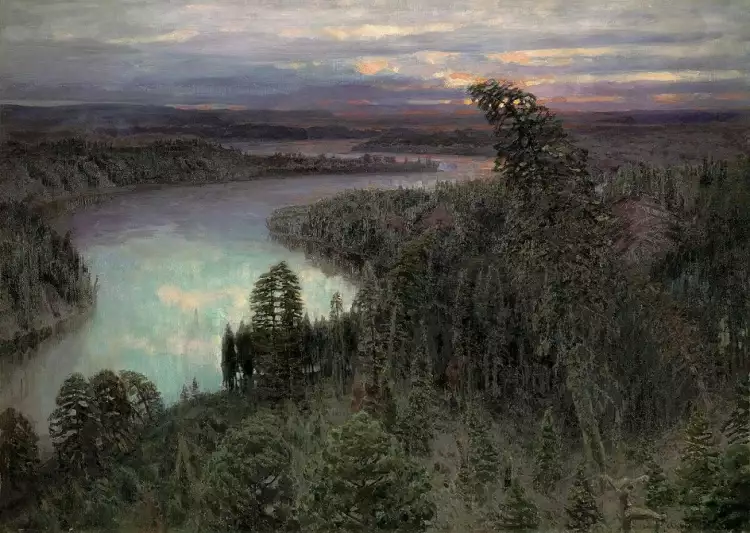 Apollinary Vasnetsov. Painting The Northern Region. Siberian River, 1899
Apollinary Vasnetsov. Painting The Northern Region. Siberian River, 1899
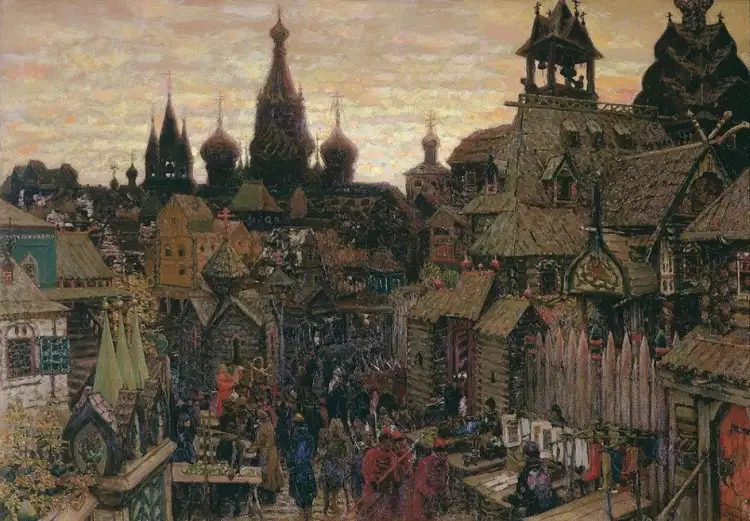 Apollinary Vasnetsov. Painting A Street in Kitay-gorod. The Beginning of the 17th Century, 1900
Apollinary Vasnetsov. Painting A Street in Kitay-gorod. The Beginning of the 17th Century, 1900
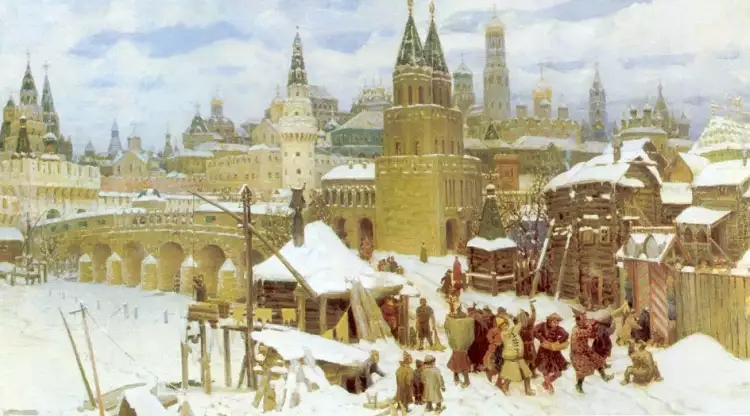 Apollinary Vasnetsov. Painting Vsekhsvyatsky Stone Bridge, 1901
Apollinary Vasnetsov. Painting Vsekhsvyatsky Stone Bridge, 1901
Apollinary Mikhailovich Vasnetsov anticipated in his works the melancholy that pervades the lines of Sergei Yesenin's poem "Rus": "Ah, my fields, my beloved furrows, you are good in your sorrow"... He did not embellish landscapes; his paintings often feature overcast skies. Yet, the eternal leitmotif in the artist's works is a hymn to the poetic beauty of the Motherland. Urban and historical landscapes, as well as views of the Central Region of Russia, the Russian North, the Urals, and Siberian lands brought the artist immortal fame.
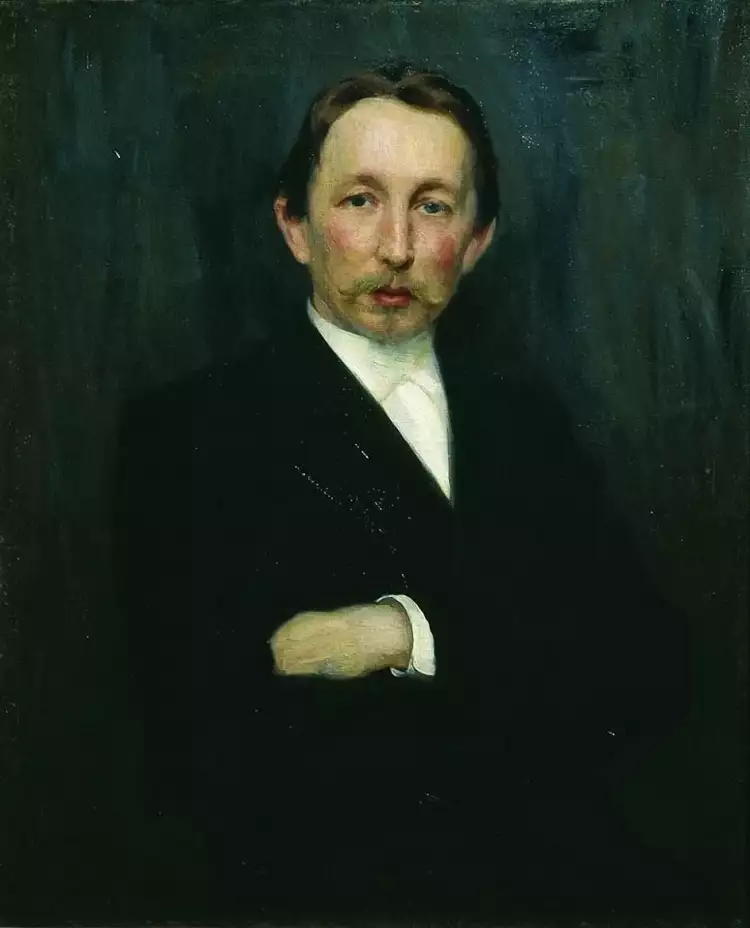
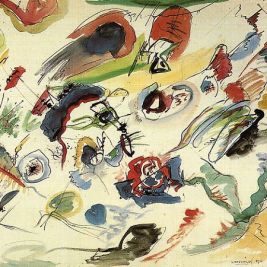 Abstractionism: an inverted painting as a precursor to a new style
Abstractionism: an inverted painting as a precursor to a new style 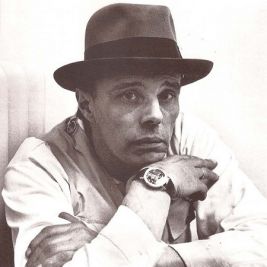 Joseph Beuys - Biography and "shamanic," mystical works of a great master
Joseph Beuys - Biography and "shamanic," mystical works of a great master 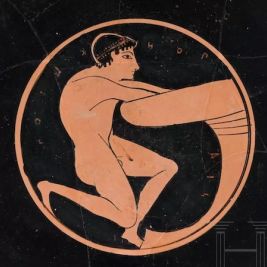 Hermann Historica Auction: Kunst, Antiquitäten & Antiken
Hermann Historica Auction: Kunst, Antiquitäten & Antiken 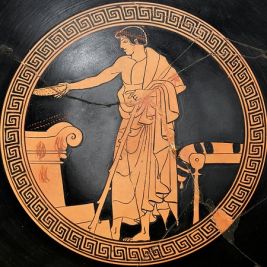 The art of Ancient Greece is an endless source of aesthetic pleasure for descendants
The art of Ancient Greece is an endless source of aesthetic pleasure for descendants  Application is a technique of decorative and applied art: essence, types, history
Application is a technique of decorative and applied art: essence, types, history  Surrealism and Abstract Gradients: Design Trends Shaping 2024
Surrealism and Abstract Gradients: Design Trends Shaping 2024 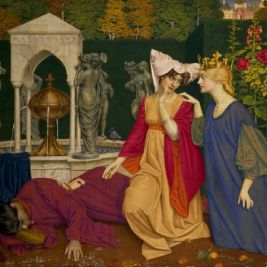 Tempera is a painting technique with a history spanning thousands of years
Tempera is a painting technique with a history spanning thousands of years  Numismatics is a serious scientific discipline or enthusiastic collection of ancient coins
Numismatics is a serious scientific discipline or enthusiastic collection of ancient coins  The National Order of the Legion of Honour
The National Order of the Legion of Honour 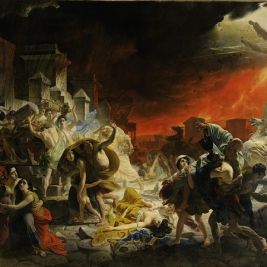 Historical Genre in Artists' Paintings
Historical Genre in Artists' Paintings